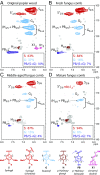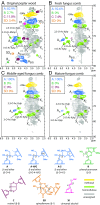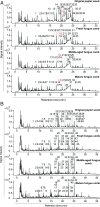Lignocellulose pretreatment in a fungus-cultivating termite
- PMID: 28424249
- PMCID: PMC5422824
- DOI: 10.1073/pnas.1618360114
Lignocellulose pretreatment in a fungus-cultivating termite
Abstract
Depolymerizing lignin, the complex phenolic polymer fortifying plant cell walls, is an essential but challenging starting point for the lignocellulosics industries. The variety of ether- and carbon-carbon interunit linkages produced via radical coupling during lignification limit chemical and biological depolymerization efficiency. In an ancient fungus-cultivating termite system, we reveal unprecedentedly rapid lignin depolymerization and degradation by combining laboratory feeding experiments, lignocellulosic compositional measurements, electron microscopy, 2D-NMR, and thermochemolysis. In a gut transit time of under 3.5 h, in young worker termites, poplar lignin sidechains are extensively cleaved and the polymer is significantly depleted, leaving a residue almost completely devoid of various condensed units that are traditionally recognized to be the most recalcitrant. Subsequently, the fungus-comb microbiome preferentially uses xylose and cleaves polysaccharides, thus facilitating final utilization of easily digestible oligosaccharides by old worker termites. This complementary symbiotic pretreatment process in the fungus-growing termite symbiosis reveals a previously unappreciated natural system for efficient lignocellulose degradation.
Keywords: NMR; age polyethism; carbohydrate; lignin; symbiosis.
Conflict of interest statement
The authors declare no conflict of interest.
Figures




References
-
- Ralph J, et al. Lignins: Natural polymers from oxidative coupling of 4-hydroxyphenyl-propanoids. Phytochem Rev. 2004;3:29–60.
-
- Chen F, Dixon RA. Lignin modification improves fermentable sugar yields for biofuel production. Nat Biotechnol. 2007;25:759–761. - PubMed
-
- Wilkerson CG, et al. Monolignol ferulate transferase introduces chemically labile linkages into the lignin backbone. Science. 2014;344:90–93. - PubMed
-
- Warnecke F, et al. Metagenomic and functional analysis of hindgut microbiota of a wood-feeding higher termite. Nature. 2007;450:560–565. - PubMed
-
- Brune A. Symbiotic digestion of lignocellulose in termite guts. Nat Rev Microbiol. 2014;12:168–180. - PubMed
Publication types
MeSH terms
Substances
LinkOut - more resources
Full Text Sources
Other Literature Sources
Molecular Biology Databases

